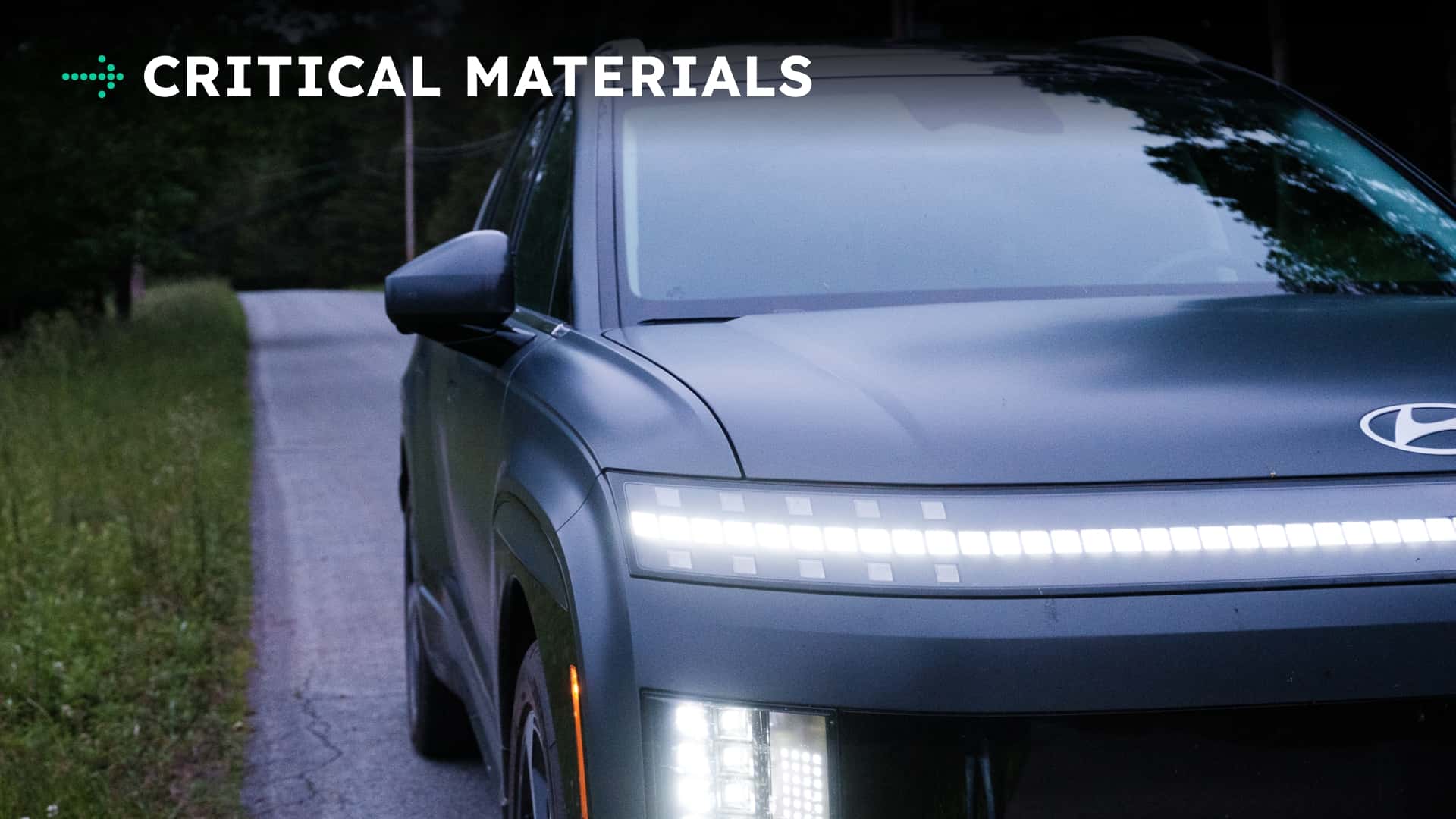
There are some economic development projects that any country would covet. Big, automotive factories, for one, especially those turning out the next-generation vehicles. High-tech jobs for generations to come. An entire ecosystem of suppliers and related companies around that project, propping up an entire region's manufacturing sector.
South Korea's Hyundai Motor Group has offered all of that, and then some, to the United States—its biggest global market, and the home country's most important ally and friend. So why can't Hyundai catch a break over here when it's pulling out the stops to be a good partner?
That kicks off this Monday edition of Critical Materials, our roundup of industry and technology news. Also on deck today: the 2026 model-year cars are here, and soon, so are the tariff-related price increases. Plus, how much Tesla cost-cutting is too much? Let's dig in.
30%: Hyundai Can't Catch A Break In America

It seems like one automaker that's been trying to do the "right thing" in America for a while seemingly can't win. For Hyundai Motor Group Executive Chair Euisun Chung, "the struggle to get in Washington’s good graces is personally vexing," the Wall Street Journal reported last week.
The latest challenge is tariffs. U.S.-South Korea tariff rate negotiations remain ongoing, unlike other nations with whom the Trump administration has signed new trade agreements. The tariff rate is currently 25% on Korean imported goods, but it's supposed to fall to 15%—it's just unclear when, exactly. The Trump administration is demanding more direct investment in the U.S., according to reports.
Hyundai must feel like what it's been doing all along. It's been piling investments into the U.S. for years now, including its Georgia Metaplant that now makes the Ioniq 5 and Ioniq 9 EVs (and soon, hybrids as well). The Metaplant is one of the most advanced car factories in the country, and it's expected to create nearly 40,000 direct and indirect jobs in the state.
That's just one example, too: Kia has ramped up its manufacturing presence here for some time, and these projects include associated industries like battery plant joint-ventures. The Korean automaker needs the U.S.: its home market is an inherently limited one, it's less of a player in Europe than others, and it currently represents less than 1% of the Chinese market. So it has every reason to be in Trump's good graces and encourage favorable export policies and U.S. domestic production.
But here's how things have gone down recently, via the WSJ:
In recent years, Chung pushed the Korean carmaker founded by his grandfather to make deeper inroads with American consumers. Hyundai and its sister brand Kia—which had once staked their reputation on decadelong warranties and budget prices—racked up design, technology and quality awards. More than half of the firm’s operating profits today come from the U.S.
Ahead of looming tariffs, Hyundai in March pledged roughly $21 billion in U.S. investments that would manifest before Trump’s second term ended. The investment earned Chung and Hyundai officials a trip to the White House. Trump hailed the investment on social media as proof his tariffs “very strongly work.”
But when Trump’s 25% tariff on global auto exports was announced days later, Hyundai wasn’t spared.
Undeterred, Hyundai took more steps to win favor in Washington. Hyundai said in April that production of a popular SUV would shift from a Kia factory in Mexico to an existing plant in Alabama. It pledged to source more components within the U.S.
Hours after South Korea’s president met Trump on Aug. 25 at the White House, with Chung in attendance again, Hyundai said it would deliver another $5 billion in American investment. Within days, the search warrant was signed for the Sept. 4 immigration raid at Hyundai’s Georgia facility.
The Metaplant raid was supposed to be a major win for Trump's tough-on-immigration law enforcement policies. But it's since been decried as a gigantic failure: a huge blow to international relations with one of America's most important allies, a setback for the Hyundai-LG battery plant being built there, and hardly a roundup of dangerous and violent criminals. Most of the more than 300 Korean workers detained and deported were engineers here on business visas to set up the battery plant and train American workers to operate there.
But I'd argue Hyundai's headaches started earlier than this. Recall that the Biden administration once "blindsided" the Korean automaker when the Inflation Reduction Act guaranteed the EV tax credit only to U.S.-made vehicles, even after the former president himself told a Korean delegation that "We’ve got your back." It's why so many Hyundai and Kia EVs got leased, which is suboptimal in the long run.
Nonetheless, “The U.S. is a market that is simply too important to ever give up on,” one former Kia investor-relations manager told the WSJ. Maybe it can catch a win with the new tariff negotiations, but it's getting hard to think of what more Hyundai could be doing to curry America's favor.
60%: Here Come The Price Increases For 2026?

The good news in this post-tax credit environment is that so far, EV prices have either held steady or dropped significantly. Automakers don't want to write off billions of dollars in EV investments or let these cars sit on dealer lots forever, so for now at least, they're baking in big incentives or even slashing prices to keep demand up.
But the American car market writ large is expected to see higher new car prices with the 2026 model-year changeover, Automotive News reports. While most automakers have held off on tariff-related price hikes until now, they're about to be done eating those costs. Emphasis mine below:
So far, most brands that are paying more to get vehicles from overseas factories onto U.S. dealership lots have largely absorbed those costs into their bottom line and expanded domestic sourcing to avoid the tariffs when possible.
But their appetite to let President Donald Trump’s import taxes erode their profits is fading as more new models roll out and tariff bills continue to pile up. The duties Trump began imposing in April could cut automakers’ operating profitability by more than $30 billion this year, analysts at Moody’s estimated Oct. 6.
“The big concern for automakers is affordability for consumers,” said Jennifer Safavian, CEO of Autos Drive America, the trade association representing international automakers in the U.S. “And that is why you’ve seen so many of them find ways to kind of eat those costs themselves and not pass it onto the consumer. Whether or not that’s sustainable remains to be seen. Personally, I don’t think it is.”
Tariffs are expected to cost automakers an average of $4,600 per vehicle by 2027 and threaten 3.9 million vehicle sales over the next three years, according to a recent analysis by the Center for Automotive Research.
For the 2026 model year, sticker prices are trending 1.8 percent higher than 2025, based on figures released as of early October, said Jessica Caldwell, associate vice president of insights at Edmunds.
Many automakers are working to get around this by sourcing more parts domestically and pulling other "levers." But there's only so much they can do before the cost simply gets passed onto the consumer.
90%: Tesla's Standard Cost Cuts, Estimated

Speaking of cost-cutting, that's certainly what the world got last week with the new Tesla Standard models. These two "new" Teslas did not exactly get a positive reception, but most people seem to think the Model 3 Standard is a better deal overall than the very stripped-out Model Y Standard.
They're each about $5,000 cheaper than the next trim up, which I'd argue isn't that much for the compromises involved. (Had they been $12,000 cheaper with the tax credit, this would've been a different story, but that's not the world we live in.)
So how much money is Tesla really saving with these content cuts? Automotive News has some estimates:
AutoForecast Solutions estimated that Tesla removed about $5,000 in costs from the Model Y base and somewhat less from the Model 3 compared with the previous entry models.
Global benchmarking firm A2MAC1 said total savings to the Model Y’s bill of materials depend on the battery type. Using a smaller version of its nickel-based pack would save about $2,200 to $2,500. But if Tesla is able to switch to an iron-based battery sourced in North America the savings could reach $4,500 to $5,000, A2MAC1 said.
A2MAC1 estimated the bill-of-materials savings from the cheaper glass at about $120. The teardown specialist said the larger headliner costs roughly the same as the smaller one used in other versions of the Model Y.
He estimated the Model Y Standard’s battery capacity was reduced by about 10 percent, saving roughly $1,500. The new trim has 321 miles of range versus 357 miles for the previous version, now called the Model Y Premium, Tesla said.
Tesla likely cut another $600 out of the drivetrain by using a less powerful motor, Fiorani said. The new standard trim has one motor at the rear and accelerates from 0 to 60 mph in 6.8 seconds versus 5.4 seconds for the Premium, Tesla said.
For the Model Y Standard, Tesla removed part of the center console that included covered storage in favor of an open bin. That is expected to save $40-$50, A2MAC1 said.
We'll see if people go for it. I tend to think that over the cost of a lease or financing term, $5,000 for a much nicer Tesla experience overall may just be worth it.
100%: How Does Hyundai Win In America?

Keep doing what it's been doing, or change tactics somehow? Drop your read on this situation into the comments.
Contact the author: patrick.george@insideevs.com








